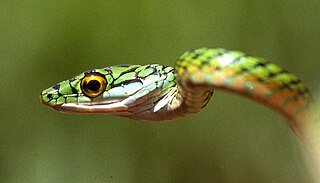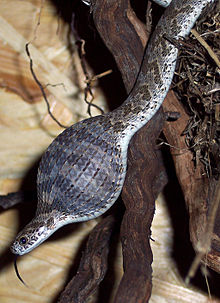
Leptophis ahaetulla, commonly known as the lora or parrot snake, is a species of medium-sized slender snake of the family Colubridae. The species is native to Central America and northern South America.

Oxyrhopus petolarius, commonly known as the forest flame snake, is a species of nonvenomous snake in the family Colubridae. The species is endemic to South America. There are three recognized subspecies.

Erythrolamprus aesculapii, also known commonly as the Aesculapian false coral snake, the South American false coral snake, and in Portuguese as bacorá, or falsa-coral, is a species of mildly venomous snake in the family Colubridae. The species is endemic to South America.

Dasypeltis is a genus of colubrid snakes. It is one of only two taxonomic groups of snakes known to have adapted to feed exclusively on eggs. Dasypeltis are non-venomous and found throughout the continent of Africa, primarily in forested or wooded habitats that are also home to numerous species of birds.
Causus maculatus is viper species found mainly in West- and Central Africa. No subspecies are currently recognized. Common names include forest rhombic night adder, West African night adder and spotted night adder. Like all other vipers, it is venomous.

Causus rhombeatus, commonly known as the rhombic night adder, is a viper species endemic to subsaharan Africa. No subspecies are currently recognized. Like all other vipers, it is venomous.
Causus bilineatus is a viper species endemic to south central Africa. No subspecies are currently recognized. Common names include lined night adder, two-lined night adder, and two-striped night adder. Like all other vipers, it is venomous.

The horseshoe whip snake is a species of snake in the family Colubridae. The species is native to southwestern Europe and northern Africa.

Eryx colubrinus, the Egyptian or Kenyan sand boa, is a species of snake in the family Boidae. The species is endemic to Northern and Eastern Africa. Three subspecies are recognized.
In the 10th edition of Systema Naturae, Carl Linnaeus described the Amphibia as:
Animals that are distinguished by a body cold and generally naked; stern and expressive countenance; harsh voice; mostly lurid color; filthy odor; a few are furnished with a horrid poison; all have cartilaginous bones, slow circulation, exquisite sight and hearing, large pulmonary vessels, lobate liver, oblong thick stomach, and cystic, hepatic, and pancreatic ducts: they are deficient in diaphragm, do not transpire (sweat), can live a long time without food, are tenatious of life, and have the power of reproducing parts which have been destroyed or lost; some undergo a metamorphosis; some cast (shed) their skin; some appear to live promiscuously on land or in the water, and some are torpid during the winter.

Dolichophis jugularis, also known commonly as the black whipsnake and the large whip snake, is a species of snake in the family Colubridae. The species is native to West Asia. There are three subspecies.

Dasypeltis atra, commonly known as the African egg-eating snake or montane egg-eater, is a species of non-venomous snake in the family Colubridae. The species is endemic to Africa.

Dasypeltis fasciata, commonly known as the Central African egg-eating snake or the western forest eggeater, is a species of snake in the family Colubridae. The species is endemic to Africa. It is one of 13 species in the genus Dasypeltis, and is occasionally kept in captivity as an exotic pet along with other members of its genus, particularly D. scabra and D. medici.
Dasypeltis loveridgei, commonly known as the dwarf egg-eater, is a species of non-venomous snake in the family Colubridae. The species is found in South Africa and Namibia.










